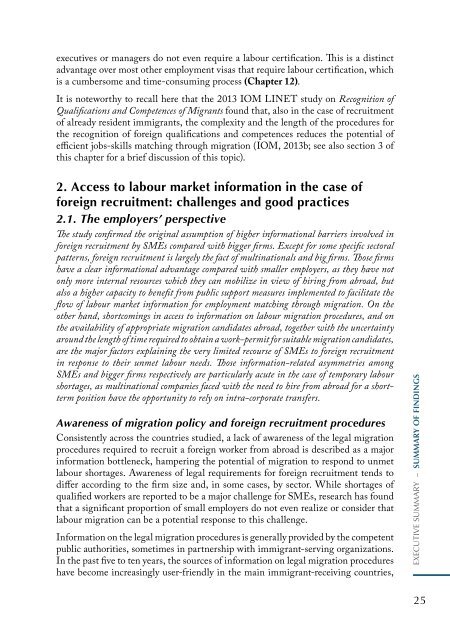International Organization for Migration (IOM)
International Organization for Migration (IOM)
International Organization for Migration (IOM)
Create successful ePaper yourself
Turn your PDF publications into a flip-book with our unique Google optimized e-Paper software.
executives or managers do not even require a labour certification. This is a distinct<br />
advantage over most other employment visas that require labour certification, which<br />
is a cumbersome and time-consuming process (Chapter 12).<br />
It is noteworthy to recall here that the 2013 <strong>IOM</strong> LINET study on Recognition of<br />
Qualifications and Competences of Migrants found that, also in the case of recruitment<br />
of already resident immigrants, the complexity and the length of the procedures <strong>for</strong><br />
the recognition of <strong>for</strong>eign qualifications and competences reduces the potential of<br />
efficient jobs-skills matching through migration (<strong>IOM</strong>, 2013b; see also section 3 of<br />
this chapter <strong>for</strong> a brief discussion of this topic).<br />
2. Access to labour market in<strong>for</strong>mation in the case of<br />
<strong>for</strong>eign recruitment: challenges and good practices<br />
2.1. The employers’ perspective<br />
The study confirmed the original assumption of higher in<strong>for</strong>mational barriers involved in<br />
<strong>for</strong>eign recruitment by SMEs compared with bigger firms. Except <strong>for</strong> some specific sectoral<br />
patterns, <strong>for</strong>eign recruitment is largely the fact of multinationals and big firms. Those firms<br />
have a clear in<strong>for</strong>mational advantage compared with smaller employers, as they have not<br />
only more internal resources which they can mobilize in view of hiring from abroad, but<br />
also a higher capacity to benefit from public support measures implemented to facilitate the<br />
flow of labour market in<strong>for</strong>mation <strong>for</strong> employment matching through migration. On the<br />
other hand, shortcomings in access to in<strong>for</strong>mation on labour migration procedures, and on<br />
the availability of appropriate migration candidates abroad, together with the uncertainty<br />
around the length of time required to obtain a work-permit <strong>for</strong> suitable migration candidates,<br />
are the major factors explaining the very limited recourse of SMEs to <strong>for</strong>eign recruitment<br />
in response to their unmet labour needs. Those in<strong>for</strong>mation-related asymmetries among<br />
SMEs and bigger firms respectively are particularly acute in the case of temporary labour<br />
shortages, as multinational companies faced with the need to hire from abroad <strong>for</strong> a shortterm<br />
position have the opportunity to rely on intra-corporate transfers.<br />
Awareness of migration policy and <strong>for</strong>eign recruitment procedures<br />
Consistently across the countries studied, a lack of awareness of the legal migration<br />
procedures required to recruit a <strong>for</strong>eign worker from abroad is described as a major<br />
in<strong>for</strong>mation bottleneck, hampering the potential of migration to respond to unmet<br />
labour shortages. Awareness of legal requirements <strong>for</strong> <strong>for</strong>eign recruitment tends to<br />
differ according to the firm size and, in some cases, by sector. While shortages of<br />
qualified workers are reported to be a major challenge <strong>for</strong> SMEs, research has found<br />
that a significant proportion of small employers do not even realize or consider that<br />
labour migration can be a potential response to this challenge.<br />
In<strong>for</strong>mation on the legal migration procedures is generally provided by the competent<br />
public authorities, sometimes in partnership with immigrant-serving organizations.<br />
In the past five to ten years, the sources of in<strong>for</strong>mation on legal migration procedures<br />
have become increasingly user-friendly in the main immigrant-receiving countries,<br />
eXecutIve summAry – SUMMARY OF FINDINGS<br />
25


